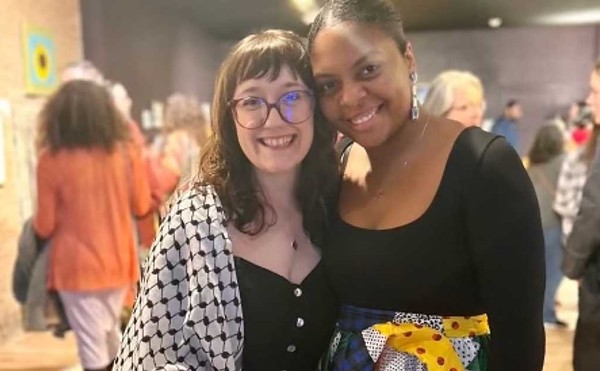A band is jamming on a dimly lit nightclub stage, magically transporting the observer from New York to New Orleans to Europe and various points along the way. Given the expansive 1931-to-1954 time frame of this performance, it’s labeled “The Greatest Jam Session That Never Happened.”
A piano, trumpet, upright bass and set of drums are the biggest stars of How High the Moon: Sarah, Ella & Pops. Combined with the actors and a biographically intriguing script, Plowshares Theatre Company produces a worthwhile jazz musical.
How High the Moon traces the musical careers and contributions of Ella Fitzgerald, Sarah Vaughan and Louis Armstrong, affectionately known as “Pops.” The show’s four-piece band — consisting of locally based players Roland Hamilton, Alonzo Armstrong, Ike Daney and Ibrahim Jones — blends some of the sharpest and most infectious rhythms a jazz lover is likely to hear outside of a concert setting. Music tells the story of how an American art form turned these aspiring performers into international icons.
The strikingly beautiful Jahra Michelle McKinney is vocally moving as “the First Lady of Song.” It’s no mean feat to do right by Fitzgerald, whose voice was at once girlishly clear, wide-ranging and refined. McKinney, a performance artist and wife of the late jazz pianist Harold McKinney, even manages to capture some of the subtle energy in Fitzgerald’s stage presence; it feels like something’s missing when she’s not in a scene.
Sheila Alyce is similarly impressive as Vaughan, who was widely regarded as Fitzgerald’s biggest rival for vocal pre-eminence in the 1940s and 1950s.
On the other hand, James Bowen as Armstrong comes up short in the area of vocal delivery, compared to his co-stars. Bowen uses an exaggerated roar in his sincere effort to imitate the most uncommonly gravelly voice known to jazz or any other genre. It’s too bad that Detroit trumpeter Marcus Belgrave wasn’t tapped to lend his naturally Armstrong-reminiscent talent to the role, but Bowen is nonetheless compelling to watch as an actor. He portrays the complexities of Armstrong’s ascension to fame in the face of a segregated society, as well as the trumpeter’s torn emotional responses to criticism that he betrayed the black race. Younger jazz cats accused Armstrong of portraying a grinning, docile stereotype at a time when he should have projected masculine pride.
Bowen’s solo, “When You’re Smiling,” is How High The Moon’s most bittersweet highlight, although the script somewhat contradictorily suggests that Armstrong was always vocal about racism.
The second act loses just a bit of the first segment’s momentum, as the musical tempo slows and dialogue increases. However, the strength of playwright Janet Choe’s script is in the way she weaves bits of fact and history from the three artists’ lives into the storyline, such as Fitzgerald’s win at the Apollo Theater talent competition and Vaughan’s dramatic transformation from church-trained performer to popular secular songstress. Choe, a Detroit native, poet and award-winning writer, demonstrates how she earned the title of Plowshares’ education director.
Supporting actors William McLin, Mateen Stewart and Danyé Evonnté Brown make their presence felt in various roles, particularly when the petite Brown struts onstage as an ornery — but hilarious — racist policeman, wearing a cop’s hat and jacket over her pretty dress.
Aside from a few lines of profanity, How High the Moon is well-suited for a general audience. Plowshares pulls together a quality collaboration of acting, music and choreography in what really amounts to an educational experience disguised as one hell of a jazz set.
How High the Moon plays through Oct. 31 at the Charles H. Wright Museum of African American History, 315 E. Warren, Detroit. Call 313-494-5800 or visit www.maah-detroit.org for more info.
Eddie B. Allen Jr. is a freelance writer. Send comments to [email protected]




